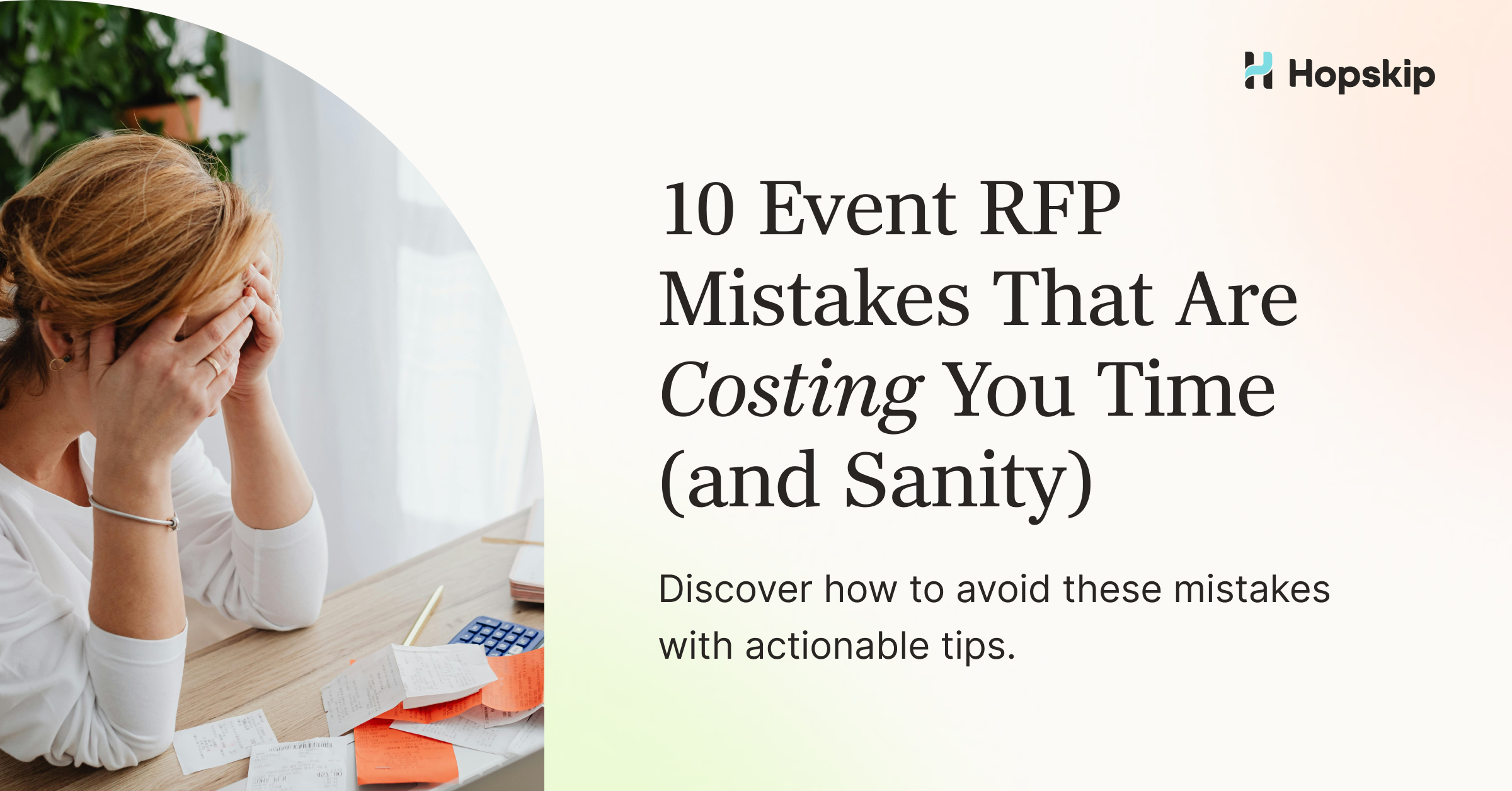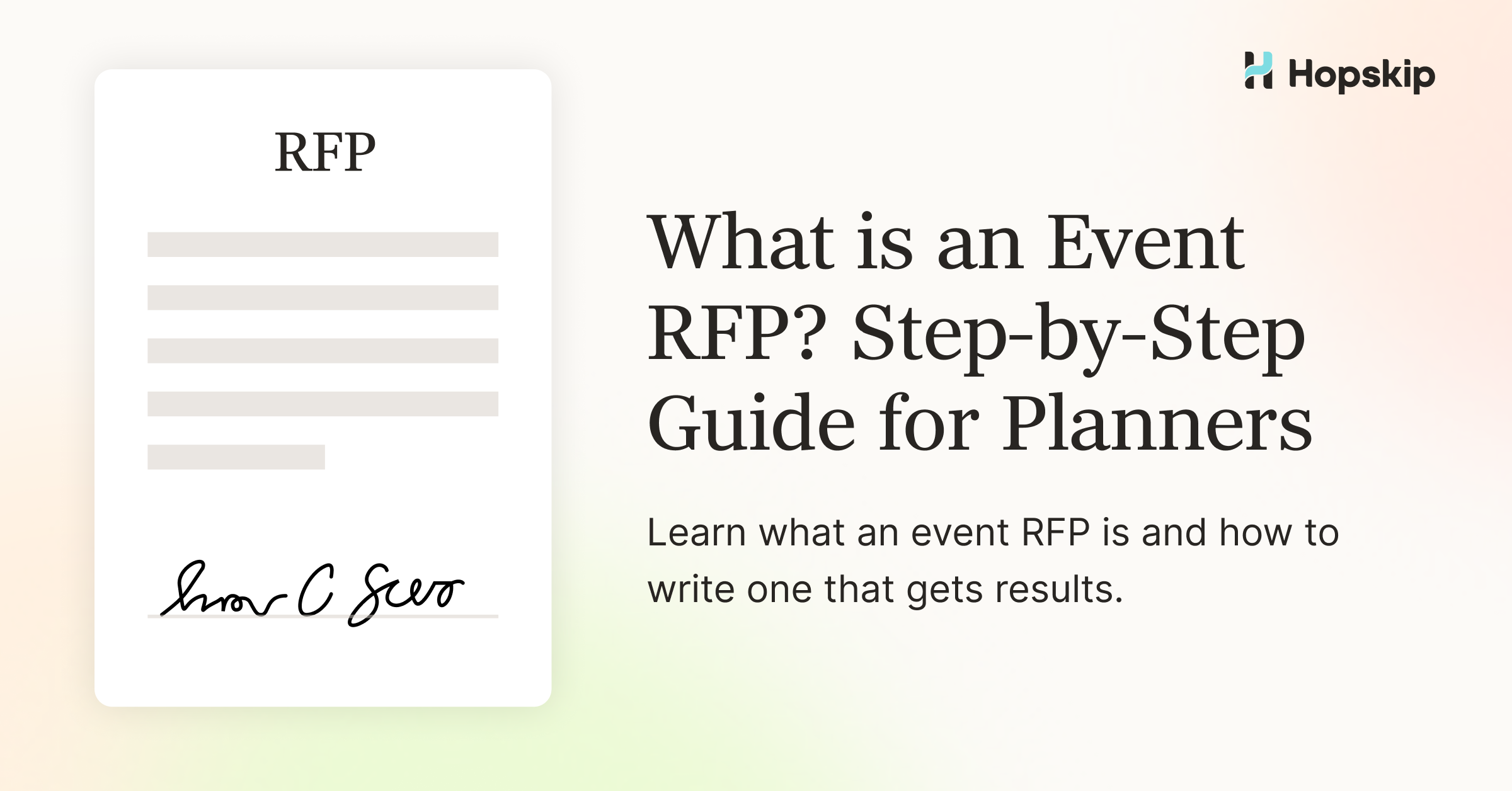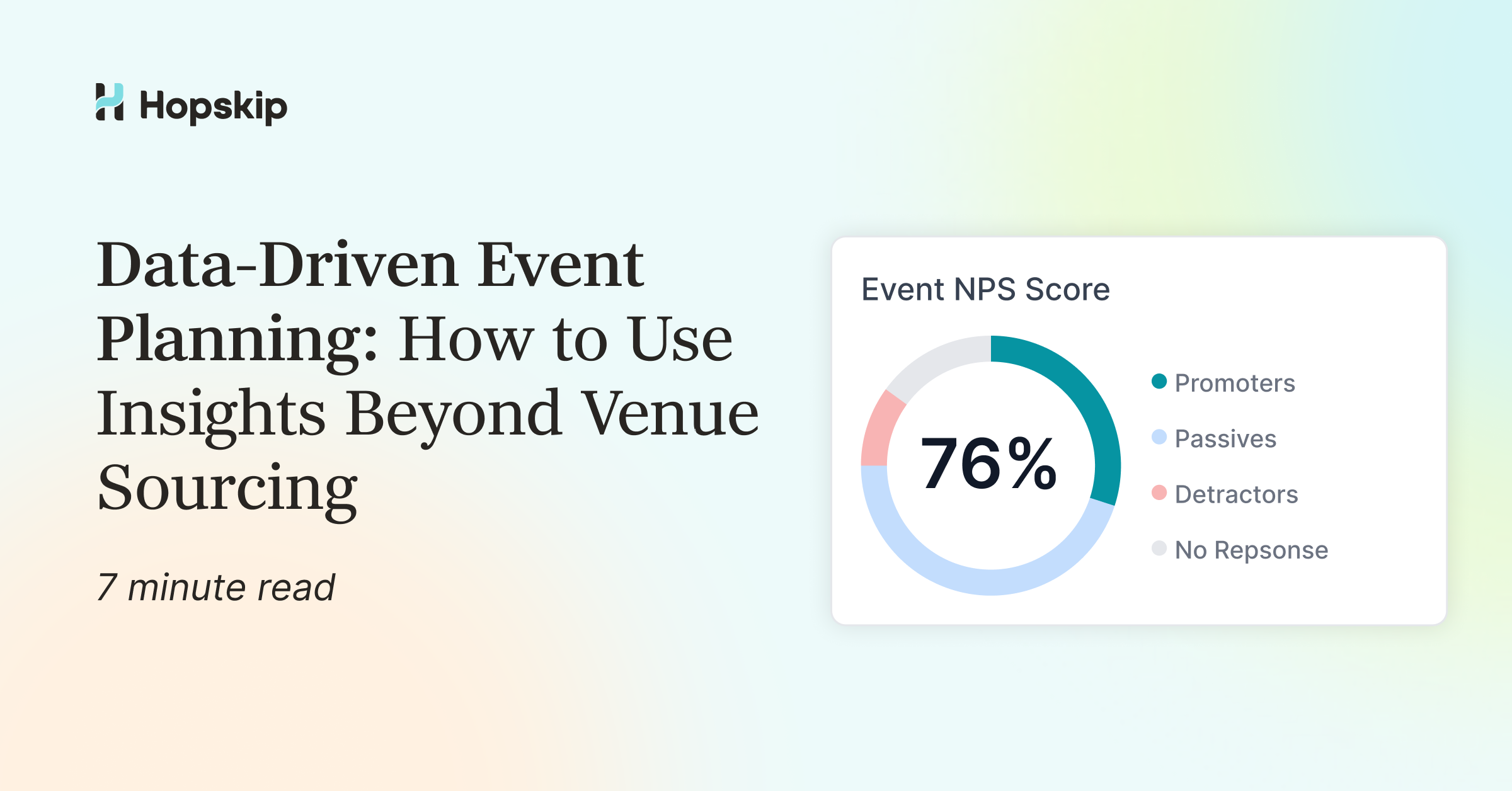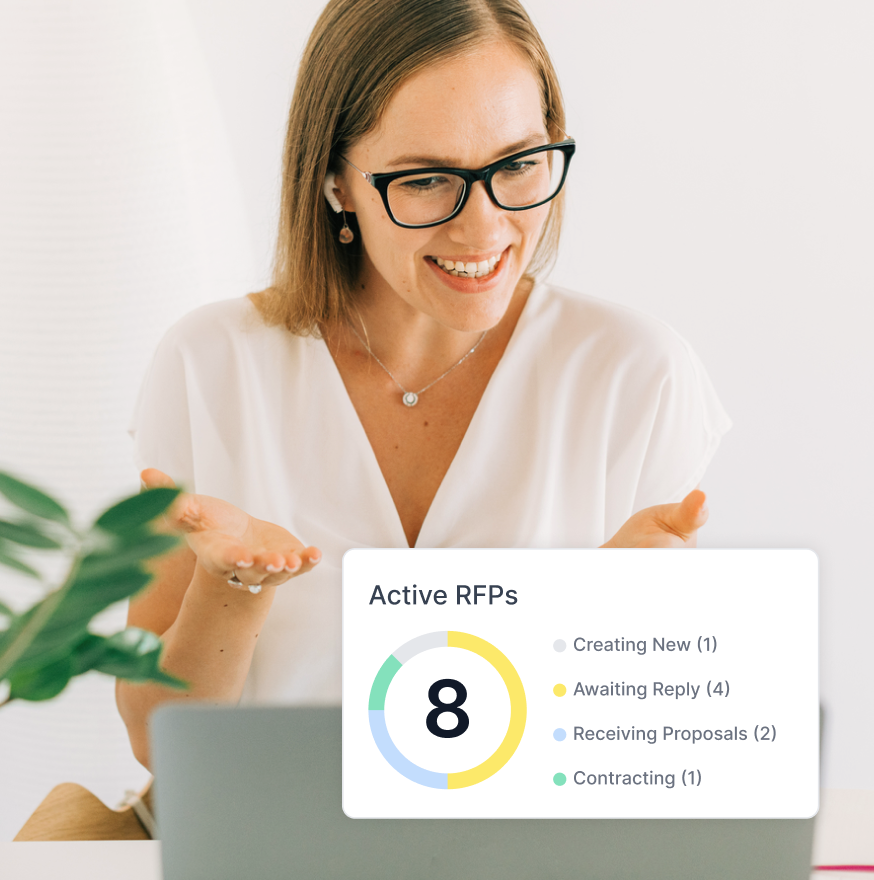Technology
Event Technology Trends to Watch in 2026
Kate Robertson
Oct 30, 2025
If you’re planning events in 2026, it’s time to lean into the technology that’s no longer optional—it’s foundational. (And no, we’re not talking about another webinar platform that promises to “revolutionize engagement” but really just has different colored buttons).
You’ve likely felt it: attendees expect more, budgets are tighter, stakeholders want data and proof, and sourcing venues still takes way too much time. At Hopskip, we built our platform because we saw these pain points firsthand—and frankly, got tired of watching talented planners drown in spreadsheets. Now we’re bringing you a look ahead at the event technology trends to watch in 2026—so you can plan smarter, not harder, and maybe even leave work before 7 PM occasionally.
1. AI-Driven Planning & Personalization (Finally Useful, Not Just Hype)
One of the biggest shifts: technology isn’t just automating tasks—it’s actually thinking ahead. And according to a 2024 Bizzabo report, 79% of event professionals say AI tools have already improved their event planning efficiency. In 2026, we’ll see AI move from “nice to have” to “how did we ever live without this?”
Why this matters for planners
Your attendees expect tailored experiences: sessions they actually want to attend, networking that doesn’t feel like speed dating in a conference room, content that speaks to their specific needs.
Your stakeholders expect proof: They want data on which sessions performed, what networking happened, what ROI you delivered. “It felt successful” doesn’t cut it anymore (even though your instincts are usually spot-on).
Your schedule is full, your budget is finite, and you’re human: You can’t manually personalize experiences for 500+ attendees while also negotiating hotel contracts and remembering to eat lunch.
What to adopt
Use AI tools for smart recommendations: Session matching, networking connections, personalized agendas based on attendee profiles and behavior. According to Forrester, personalized event experiences can increase attendee satisfaction by up to 40%.
Automate the repetitive stuff: Personalized email journeys, smart agenda builders, attendee behavior predictions.
At the sourcing level (where Hopskip lives), use tools that surface the right venues faster, show cost-savings automatically, and compare options side-by-side. For example, Hopskip lets you compare proposals with one click and automatically generate branded presentations—helping you demonstrate value in minutes, not days. Our users report saving an average of 12-30 hours per RFP cycle.
Monitor engagement, not just cost: Data shows events with high engagement scores secure 23% larger budgets for the following year. Track what drives repeat business.
2. Immersive Hybrid and Blended Experiences (No More “Zoom in the Back of the Room”)
“Hybrid” is no longer “in-person plus livestream where remote people feel like they’re watching through a window.” In 2026, it means fully integrated, immersive, nobody-feels-like-a-second-class-citizen experiences.
The planner pain point
You’ve run virtual and in-person events. You know a simple livestream isn’t enough. Remote attendees feel ignored, in-person attendees expect Instagram-worthy moments, and sponsors want measurable ROI that proves their investment mattered.
What the trend looks like (with actual numbers)
Truly integrated experiences: Breakout sessions where remote participants actually participate (not just lurk), real-time polls that include everyone, VR or AR elements that make remote attendance feel premium. A 2024 EventMB study found that 67% of attendees say they’d pay more for events with high-quality hybrid experiences.
Seamless networking: Remote participants get networking tools that mimic those hallway chats; physical attendees engage via digital kiosks or mixed reality. Research shows networking is the #1 reason people attend events in person—so make it work for everyone.
Venue sourcing considers tech infrastructure: Strong connectivity (not “the hotel says they have WiFi”), professional AV capabilities, hybrid-ready rooms with proper lighting and sound.
What to do now
When sourcing venues, add tech requirements: Bandwidth specs (aim for at least 100 Mbps dedicated), streaming gear compatibility, on-site tech support.
Choose platforms that consolidate data: Attendance, engagement, follow-up—all in one dashboard. According to industry data, event planners use an average of 7-10 different tools per event. That’s too many logins.
Train your team on hybrid best practices: Not just “we’ll record the session,” but “we’ll build an experience everyone talks about.”
At Hopskip, our sourcing tools help you get clarity on cost and contract details so you can evaluate hybrid venue packages confidently, and negotiate better deals because you understand exactly what you’re paying for.
3. Data, Insights & Demonstrating Value (AKA: Finally Proving You’re Worth It)
As planning becomes more complex, stakeholders expect more transparency. They want clear dashboards, real-time reporting, cost vs impact metrics. You know the drill. The good news: 2026 is going to give you the tools to deliver it—and finally get the credit you deserve.
What planners struggle with
Manual data compilation: Pulling information from spreadsheets, email threads, and that one document someone saved on their desktop but nobody can find.
Showing ROI beyond attendance: “We had 300 attendees” isn’t enough. They want “we saved $47K in sourcing, negotiated 15% concessions, delivered a 4.7/5 satisfaction rating, and generated 89 qualified leads.”
Proving strategic value: So your events become investments, not expenses. Research shows that only 34% of event planners feel confident presenting ROI data to executives, let’s change that.
What the trend means
Dashboards that actually work: Showing sourcing metrics (cost per attendee, venue response time), engagement metrics (networking match rate, session participation rate), and sustainability metrics (carbon offsets, waste reduced).
Tools that integrate automatically: Proposals, budgets, venue responses, attendee behavior—all feeding into one view. No more exporting CSV files at midnight.
Your value becomes visible: And your role becomes more strategic. According to a 2024 survey, planners who present data-driven reports are 3x more likely to receive budget increases.
What to adopt now
Build or adopt sourcing and RFP tools that generate reports automatically. Hopskip’s tools let you export branded presentations and track cost savings from concessions with zero manual work. Our clients report saving an average of $15K-$50K per event in negotiated concessions—and now they can prove it.
Define metrics early: Identify what matters to your stakeholders (cost savings, brand exposure, attendee experience, lead generation) and ensure your tech tracks it.
Use data for smarter decisions: Not just “this venue is cheaper,” but “this venue’s response rate is 40% higher,” “venues in this location drove 25% more hotel room bookings,” “this conference room layout increased networking connections by 18%.”
4. Venue Sourcing Gets Smarter (Finally!)
Let’s zoom in on the particular pain point many of you know too well: venue sourcing. It’s time-consuming, repetitive, full of email chains that somehow CC fifteen people but still miss the decision-maker. 2026’s trend? Smarter sourcing with tools that don’t make you want to throw your laptop out the window.
Why it’s still a big challenge
You’re juggling dozens of hotel proposals: Comparisons, rates, contract clauses, that one venue that still hasn’t responded, all tracked manually or in spreadsheets that crash when you need them most.
You need to prove value: Show cost-savings, track venue response times, get internal buy-in before someone questions your venue choice in a meeting.
Communication breakdowns waste time and money: The average RFP process involves 37 email exchanges per venue. That’s exhausting.
What the trend looks like
Platforms optimized for sourcing: Search 150,000+ hotels globally, compare side-by-side with rates, fees, taxes, concessions all visible. Hopskip allows exactly this, and our users complete RFPs 50% faster than traditional methods.
Automated templating: Reuse RFP templates, save common questions and contract clauses, establish straightforward workflows. All available within Hopskip.
Integration of your relationships: NSOs, GSOs, DMOs, preferred vendors—everyone in one platform so nothing falls through the cracks. Hopskip’s platform keeps your trusted contacts in the loop and maintains those valuable relationships.
Better outcomes: Faster response times (Hopskip users report 2x faster venue responses), fewer manual tasks, fewer errors, more negotiating power.
What to adopt now
Standardize your RFP templates: When you kick off venue sourcing, it should be consistent and quick. Build your own RFP templates in Hopskip as a starting point and customize for your brand.
Use a sourcing-specific tool: Not generic event software that treats sourcing as an afterthought. Time saved equals budget freed for strategy (and maybe that fancy coffee maker for your office).
Train your procurement team: Make sure you’re using all features—notes, lists, filters for cost savings, branded presentations.
Collect historical data: Track how many proposals you sent, conversion rates, cost saved. Industry benchmark: top-performing planners convert 18-22% of RFPs into bookings. How do you compare?
5. Sustainability, Accessibility & Tech Ethics (Doing Well by Doing Good)
Technology is only part of the story. In 2026, your event’s success won’t just depend on “what’s new,” but on “what’s responsible.” Attendees and clients expect environmental care, accessibility, data privacy—and tech will play a starring role in all of these. (Also, Gen Z attendees will absolutely call you out on social media if you don’t prioritize this stuff.)
The planner challenge
Sustainability policies are non-negotiable: 73% of event attendees say they’re more likely to attend events from organizations with strong sustainability commitments (MeetGreen, 2024).
Accessibility matters: Remote and in-person attendees need inclusive experiences—language translation, closed captions, mobility support, neurodivergent-friendly spaces. In the U.S. alone, 26% of adults have some type of disability. That’s a quarter of your potential audience.
Data privacy is personal: As you lean more into AI and personalization, you must handle attendee data ethically and securely. 87% of consumers say they won’t do business with a company if they have concerns about its security practices (Cisco, 2024).
What the trend means
Tech supporting sustainability: Digital signage instead of printed materials (save an average of $2-5K per event), apps instead of paper programs, tracking carbon footprint of travel and venue choices.
Technology enabling accessibility: Real-time translation, live transcription, accessible event apps with screen reader compatibility, VR/AR for inclusive experiences that transcend physical limitations.
Governance and trust: Tools that ensure data provenance, security, clear opt-ins and transparency. Research shows “digital provenance” and “preemptive cybersecurity” are major 2026 tech trends—Gartner predicts that by 2026, 60% of enterprises will prioritize these in their event tech stack.
What to adopt now
Build sustainability and accessibility into venue selection: Use tech to monitor and report these metrics. When using Hopskip, add sustainability and accessibility requirements to your RFP templates.
Choose platforms and vendors with clear policies: How do they handle data security? What accessibility features do they offer? Can they show compliance certifications? Don’t be shy about asking—this is your attendees’ data and experience.
Make it part of your sourcing checklist: Build sustainability and accessibility criteria into your venue evaluation process.
Prepare your impact story: Be ready to show stakeholders how using tech helped reduce waste, increase inclusion, and deliver meaningful positive impact alongside business results.
6. The Rise of Immersive Spatial & Experience Tech (Making Events Actually Memorable)
Looking just beyond traditional tech, 2026 will be the year where immersive experiences—AR/VR, spatial computing, 360° environments—move out of “wow” tech demos and into actual events that people remember months later.
Planner pain points
How do you make events memorable, not just functional? Most attendees forget 80% of event content within 48 hours (unless something truly stands out).
How do you engage remote audiences with the same energy as live ones? Virtual fatigue is real—76% of remote attendees multitask during virtual events (EventMB, 2024).
How do you stand out in a crowded event market? There are approximately 1.5 million business events held annually in the U.S. alone. You need differentiation.
What the trend looks like
On-site AR for guest engagement: Guests point their phones at signage and see overlays, interactive installations, gamified scavenger hunts, or product demos that come alive. Early adopters report 45% higher engagement with AR elements compared to traditional displays.
Remote attendees join via immersive platforms: VR or spatial environments that mimic (or exceed) the in-person feel—no more tiny Brady Bunch boxes on a screen.
“Phygital” hybrid moments: Physical + digital experiences that create unique, shareable moments. Think: holographic speakers, interactive projection mapping, mixed reality networking lounges.
What to adopt now
Start small: Don’t deploy full VR unless you have budget and buy-in. Instead, pilot immersive tech elements: interactive photo booths, AR signage, live gamified polling, QR-activated experiences.
Ask the right venue questions: When sourcing, inquire about immersive possibilities—display walls, AR/VR infrastructure, power requirements for gamified experiences, lighting that supports projection mapping.
Use immersive tech in your stakeholder storytelling: Not just “we had this cool tech,” but “we created an experience that generated 3,500 social media impressions and a 92% ‘would recommend’ rating.”
Track meaningful metrics: Pair immersive tech with your data dashboard to measure “time in experience,” “interaction rate,” “content recall,” “guest satisfaction.” Prove the ROI so you can do it again (and get more budget).
Conclusion: Choose Technology That Solves Real Problems
Navigating technology in 2026 doesn’t mean chasing every shiny tool that promises to revolutionize your workflow (spoiler: most won’t). It means choosing the right ones that solve your actual problems: sourcing efficiency, attendee experience, measurable value, and inclusive & sustainable events that make a real difference.
As an event planner, you’re not just executing logistics—you’re designing experiences, delivering business value, leading teams, and somehow keeping your cool when the AV goes down five minutes before your keynote speaker. In that role, you deserve tools built specifically for you, not adapted from software designed for something else entirely.
At Hopskip, we built a platform that understands your pain points: sourcing dozens of hotels, comparing proposals without losing your mind, demonstrating cost savings in language executives understand, and surfacing the right data for your stakeholders. Our users report cutting sourcing time in half while saving an average of $15K-$50K per event in negotiated concessions. That’s not just efficiency—that’s impact you can show.
As you plan your next event in 2026, keep these questions in mind:
Can this tool save me time or just add complexity? (Be honest. Life’s too short for tools that require three tutorials and a prayer.)
Can I measure its impact and show my stakeholders? (Because “trust me, it’s great” only works until budget season.)
Does it support inclusivity, sustainability and transparency? (Your attendees care. Your leadership cares. You should care.)
Does it align with how I actually plan, not how a generic system thinks I should? (You’re the expert. Your tools should adapt to you.)
If you’re ready to explore how smarter sourcing and tech-enabled planning can free up your time for what matters most—creating meaningful moments people actually remember—let’s talk.
Ready to Dive Deeper?
Join our next webinar: Check out our upcoming webinars.
Schedule a demo: See how Hopskip can cut your sourcing time in half and help you demonstrate real value to your stakeholders: Book a Demo.




